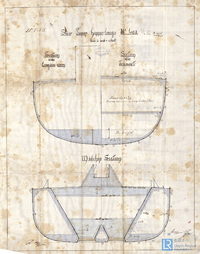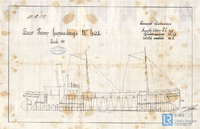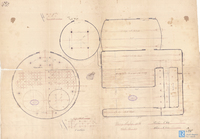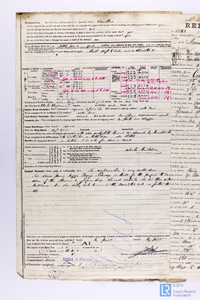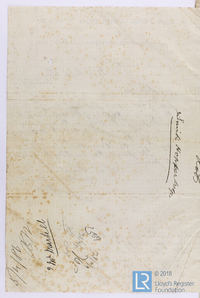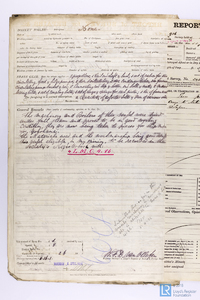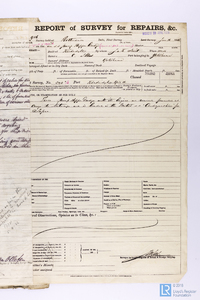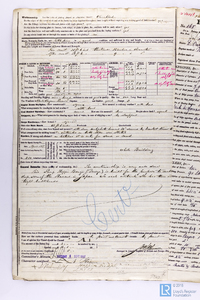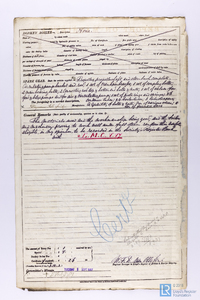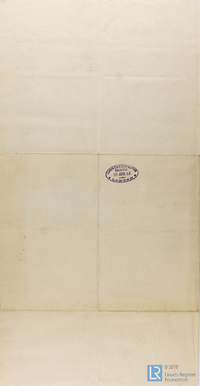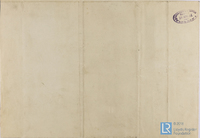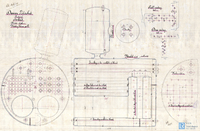- Related documents Related
- Complete documents list Documents
- Report ship? Report?
Use the data export button to extract customised data sets from the Ship Plan and Survey Report Collection. Available in TSV and CSV formats.
Name of ship as recorded on the record
Ship name
Kisogawa ( Particulars for Record of Material of Boilers for Kisogawa, 3 April 1885 1885, Midship Section and Section over Engine Room for Kisogawa, 18 August 1885 1885, Profile Plan for Kisogawa, 18 August 1885 1885, Boiler plan for Kisogawa, 18 July 1885 1885, Iron Ship Report of Survey for Kisogawa, 3 April 1886 1886, Correspondence from Jain C W Loos to the Secretary of Lloyds Register London regarding vessels Kisogawa, Laardam and Edam, 3 April 1886 1886, Report on machinery for Kisogawa, 22 March 1886 1886, Report of survey for Repairs for Kisogawa, 26 June 1886 1886, Iron Ship Report of Survey for Kisogawa, 30 August 1887 1887, Report on machinery for Kisogawa, 25 August 1887 1887, Plan of Section over engine room, section after foremast for Kisogawa, 29 April 1887 1887, Midship Section plan for Kisogawa, 29 April 1887 1887, Boiler plan for Kisogawa 1887, Correspondence memo regarding 402, Kisogawa no date )
The process of transferring a vessel to water, but not necessarily her completion.
Launch Date
18/07/1886 ( Particulars for Record of Material of Boilers for Kisogawa, 3 April 1885 1885, Midship Section and Section over Engine Room for Kisogawa, 18 August 1885 1885, Profile Plan for Kisogawa, 18 August 1885 1885, Boiler plan for Kisogawa, 18 July 1885 1885, Iron Ship Report of Survey for Kisogawa, 3 April 1886 1886, Correspondence from Jain C W Loos to the Secretary of Lloyds Register London regarding vessels Kisogawa, Laardam and Edam, 3 April 1886 1886, Report on machinery for Kisogawa, 22 March 1886 1886, Report of survey for Repairs for Kisogawa, 26 June 1886 1886, Correspondence memo regarding 402, Kisogawa no date )
01/07/1887 ( Iron Ship Report of Survey for Kisogawa, 30 August 1887 1887, Report on machinery for Kisogawa, 25 August 1887 1887, Plan of Section over engine room, section after foremast for Kisogawa, 29 April 1887 1887, Midship Section plan for Kisogawa, 29 April 1887 1887, Boiler plan for Kisogawa 1887 )
Unique identifier for a given ship, it is assigned by a builder.
Yard no
410 ( Particulars for Record of Material of Boilers for Kisogawa, 3 April 1885 1885, Midship Section and Section over Engine Room for Kisogawa, 18 August 1885 1885, Profile Plan for Kisogawa, 18 August 1885 1885, Boiler plan for Kisogawa, 18 July 1885 1885, Iron Ship Report of Survey for Kisogawa, 3 April 1886 1886, Correspondence from Jain C W Loos to the Secretary of Lloyds Register London regarding vessels Kisogawa, Laardam and Edam, 3 April 1886 1886, Report on machinery for Kisogawa, 22 March 1886 1886, Report of survey for Repairs for Kisogawa, 26 June 1886 1886, Iron Ship Report of Survey for Kisogawa, 30 August 1887 1887, Report on machinery for Kisogawa, 25 August 1887 1887, Plan of Section over engine room, section after foremast for Kisogawa, 29 April 1887 1887, Midship Section plan for Kisogawa, 29 April 1887 1887, Boiler plan for Kisogawa 1887, Correspondence memo regarding 402, Kisogawa no date )
The country in which the vessel’s construction took place, at the time of writing.
Country of build
The Netherlands ( Particulars for Record of Material of Boilers for Kisogawa, 3 April 1885 1885, Midship Section and Section over Engine Room for Kisogawa, 18 August 1885 1885, Profile Plan for Kisogawa, 18 August 1885 1885, Boiler plan for Kisogawa, 18 July 1885 1885, Iron Ship Report of Survey for Kisogawa, 3 April 1886 1886, Correspondence from Jain C W Loos to the Secretary of Lloyds Register London regarding vessels Kisogawa, Laardam and Edam, 3 April 1886 1886, Report on machinery for Kisogawa, 22 March 1886 1886, Report of survey for Repairs for Kisogawa, 26 June 1886 1886, Iron Ship Report of Survey for Kisogawa, 30 August 1887 1887, Report on machinery for Kisogawa, 25 August 1887 1887, Plan of Section over engine room, section after foremast for Kisogawa, 29 April 1887 1887, Midship Section plan for Kisogawa, 29 April 1887 1887, Boiler plan for Kisogawa 1887, Correspondence memo regarding 402, Kisogawa no date )
The listed port to which a given vessel belongs.
Port belonging to
Japan ( Particulars for Record of Material of Boilers for Kisogawa, 3 April 1885 1885, Iron Ship Report of Survey for Kisogawa, 3 April 1886 1886, Correspondence from Jain C W Loos to the Secretary of Lloyds Register London regarding vessels Kisogawa, Laardam and Edam, 3 April 1886 1886, Iron Ship Report of Survey for Kisogawa, 30 August 1887 1887, Correspondence memo regarding 402, Kisogawa no date )
Yokohama ( Report on machinery for Kisogawa, 22 March 1886 1886, Report of survey for Repairs for Kisogawa, 26 June 1886 1886 )
Kinderdijk ( Report on machinery for Kisogawa, 25 August 1887 1887 )
Broad categories and subdivisions of vessels related to their purpose or function.
Ship type
Pump Hopper Barge ( Particulars for Record of Material of Boilers for Kisogawa, 3 April 1885 1885, Midship Section and Section over Engine Room for Kisogawa, 18 August 1885 1885, Profile Plan for Kisogawa, 18 August 1885 1885, Boiler plan for Kisogawa, 18 July 1885 1885, Iron Ship Report of Survey for Kisogawa, 3 April 1886 1886, Correspondence from Jain C W Loos to the Secretary of Lloyds Register London regarding vessels Kisogawa, Laardam and Edam, 3 April 1886 1886, Report on machinery for Kisogawa, 22 March 1886 1886, Report of survey for Repairs for Kisogawa, 26 June 1886 1886, Iron Ship Report of Survey for Kisogawa, 30 August 1887 1887, Report on machinery for Kisogawa, 25 August 1887 1887, Plan of Section over engine room, section after foremast for Kisogawa, 29 April 1887 1887, Midship Section plan for Kisogawa, 29 April 1887 1887, Boiler plan for Kisogawa 1887, Correspondence memo regarding 402, Kisogawa no date )
Is the steamer assisted by sail?
Sail assisted steamer
No ( Particulars for Record of Material of Boilers for Kisogawa, 3 April 1885 1885, Midship Section and Section over Engine Room for Kisogawa, 18 August 1885 1885, Profile Plan for Kisogawa, 18 August 1885 1885, Boiler plan for Kisogawa, 18 July 1885 1885, Iron Ship Report of Survey for Kisogawa, 3 April 1886 1886, Correspondence from Jain C W Loos to the Secretary of Lloyds Register London regarding vessels Kisogawa, Laardam and Edam, 3 April 1886 1886, Report on machinery for Kisogawa, 22 March 1886 1886, Report of survey for Repairs for Kisogawa, 26 June 1886 1886, Iron Ship Report of Survey for Kisogawa, 30 August 1887 1887, Report on machinery for Kisogawa, 25 August 1887 1887, Plan of Section over engine room, section after foremast for Kisogawa, 29 April 1887 1887, Midship Section plan for Kisogawa, 29 April 1887 1887, Boiler plan for Kisogawa 1887, Correspondence memo regarding 402, Kisogawa no date )
Is machinery fitted at the aft of the vessel?
Machinery aft?
No ( Particulars for Record of Material of Boilers for Kisogawa, 3 April 1885 1885, Midship Section and Section over Engine Room for Kisogawa, 18 August 1885 1885, Profile Plan for Kisogawa, 18 August 1885 1885, Boiler plan for Kisogawa, 18 July 1885 1885, Iron Ship Report of Survey for Kisogawa, 3 April 1886 1886, Correspondence from Jain C W Loos to the Secretary of Lloyds Register London regarding vessels Kisogawa, Laardam and Edam, 3 April 1886 1886, Report on machinery for Kisogawa, 22 March 1886 1886, Report of survey for Repairs for Kisogawa, 26 June 1886 1886, Iron Ship Report of Survey for Kisogawa, 30 August 1887 1887, Report on machinery for Kisogawa, 25 August 1887 1887, Plan of Section over engine room, section after foremast for Kisogawa, 29 April 1887 1887, Midship Section plan for Kisogawa, 29 April 1887 1887, Boiler plan for Kisogawa 1887, Correspondence memo regarding 402, Kisogawa no date )
Generally a smaller additional auxiliary boiler (often used while the vessel is at port).
Is a donkey boiler fitted?
No ( Particulars for Record of Material of Boilers for Kisogawa, 3 April 1885 1885, Midship Section and Section over Engine Room for Kisogawa, 18 August 1885 1885, Profile Plan for Kisogawa, 18 August 1885 1885, Boiler plan for Kisogawa, 18 July 1885 1885, Iron Ship Report of Survey for Kisogawa, 3 April 1886 1886, Correspondence from Jain C W Loos to the Secretary of Lloyds Register London regarding vessels Kisogawa, Laardam and Edam, 3 April 1886 1886, Report on machinery for Kisogawa, 22 March 1886 1886, Report of survey for Repairs for Kisogawa, 26 June 1886 1886, Iron Ship Report of Survey for Kisogawa, 30 August 1887 1887, Report on machinery for Kisogawa, 25 August 1887 1887, Plan of Section over engine room, section after foremast for Kisogawa, 29 April 1887 1887, Midship Section plan for Kisogawa, 29 April 1887 1887, Boiler plan for Kisogawa 1887, Correspondence memo regarding 402, Kisogawa no date )
Name of the Proving House responsible for the public testing and certification of a vessel’s anchors and/or chain cables.
Lloyd's Proving House?
No ( Particulars for Record of Material of Boilers for Kisogawa, 3 April 1885 1885, Midship Section and Section over Engine Room for Kisogawa, 18 August 1885 1885, Profile Plan for Kisogawa, 18 August 1885 1885, Boiler plan for Kisogawa, 18 July 1885 1885, Iron Ship Report of Survey for Kisogawa, 3 April 1886 1886, Correspondence from Jain C W Loos to the Secretary of Lloyds Register London regarding vessels Kisogawa, Laardam and Edam, 3 April 1886 1886, Report on machinery for Kisogawa, 22 March 1886 1886, Report of survey for Repairs for Kisogawa, 26 June 1886 1886, Iron Ship Report of Survey for Kisogawa, 30 August 1887 1887, Report on machinery for Kisogawa, 25 August 1887 1887, Plan of Section over engine room, section after foremast for Kisogawa, 29 April 1887 1887, Midship Section plan for Kisogawa, 29 April 1887 1887, Boiler plan for Kisogawa 1887, Correspondence memo regarding 402, Kisogawa no date )
The individual and/or organisation listed
Ship owner
C Illies ( Iron Ship Report of Survey for Kisogawa, 3 April 1886 1886 )
C Illies & Co ( Report on machinery for Kisogawa, 22 March 1886 1886, Report of survey for Repairs for Kisogawa, 26 June 1886 1886 )
Classification symbol assigned to a vessel by Lloyd’s Register’s Classing Committee denoting the quality of construction and maintenance.
Classification
A1 steam hopper barge ( Iron Ship Report of Survey for Kisogawa, 3 April 1886 1886 )
A1 steam; +LMC 8,87; Hopper dredger LARC ( Iron Ship Report of Survey for Kisogawa, 30 August 1887 1887 )
+LMC 8,87 ( Report on machinery for Kisogawa, 25 August 1887 1887 )
A ship’s total internal capacity of a ship measured in register tons from the top of the floors to the tonnage deck.
Under Deck Tonnage
322 ( Iron Ship Report of Survey for Kisogawa, 3 April 1886 1886 )
263 ( Iron Ship Report of Survey for Kisogawa, 30 August 1887 1887 )
Location of construction for a vessel’s engines.
Location of engine build
Kinderdijk ( Report on machinery for Kisogawa, 22 March 1886 1886, Report on machinery for Kisogawa, 25 August 1887 1887 )
Date in which construction of a vessel’s engines were completed.
Year of engine build
1886 ( Report on machinery for Kisogawa, 22 March 1886 1886 )
1887 ( Report on machinery for Kisogawa, 25 August 1887 1887 )
Abbreviations of the names of ports with Lloyd’s Register survey offices.
Port of survey abbreviations
Rot ( Iron Ship Report of Survey for Kisogawa, 30 August 1887 1887 )
The name of the port/place of destination given.
Destined voyage
Japan ( Iron Ship Report of Survey for Kisogawa, 30 August 1887 1887 )
Used to indicate the capability of early reciprocating steam engines, based on dimensions rather than performance. It is not a true indication of actual engine power.
Horsepower nominal
50 ( Iron Ship Report of Survey for Kisogawa, 30 August 1887 1887 )
Length of a ship along the summer load line from the vessel’s stem to the sternpost.
Length between perpendiculars
137' 7" ( Iron Ship Report of Survey for Kisogawa, 30 August 1887 1887 )
Also referred to as extreme breadth. The distance from the extreme starboard side to the extreme port side.
Registered Beam
28' 3" ( Iron Ship Report of Survey for Kisogawa, 30 August 1887 1887 )
The year in which a vessel’s construction is completed.
Year of ship completion
1886 ( Particulars for Record of Material of Boilers for Kisogawa, 3 April 1885 1885, Midship Section and Section over Engine Room for Kisogawa, 18 August 1885 1885, Profile Plan for Kisogawa, 18 August 1885 1885, Boiler plan for Kisogawa, 18 July 1885 1885, Iron Ship Report of Survey for Kisogawa, 3 April 1886 1886, Correspondence from Jain C W Loos to the Secretary of Lloyds Register London regarding vessels Kisogawa, Laardam and Edam, 3 April 1886 1886, Report on machinery for Kisogawa, 22 March 1886 1886, Report of survey for Repairs for Kisogawa, 26 June 1886 1886, Correspondence memo regarding 402, Kisogawa no date )
1887 ( Iron Ship Report of Survey for Kisogawa, 30 August 1887 1887, Report on machinery for Kisogawa, 25 August 1887 1887, Plan of Section over engine room, section after foremast for Kisogawa, 29 April 1887 1887, Midship Section plan for Kisogawa, 29 April 1887 1887, Boiler plan for Kisogawa 1887 )
The individual and/or organisation listed as having been responsible for constructing the vessel. This can/may be the same as the owner and/or manager.
Shipbuilder
J & K Smit ( Particulars for Record of Material of Boilers for Kisogawa, 3 April 1885 1885, Midship Section and Section over Engine Room for Kisogawa, 18 August 1885 1885, Profile Plan for Kisogawa, 18 August 1885 1885, Boiler plan for Kisogawa, 18 July 1885 1885, Iron Ship Report of Survey for Kisogawa, 3 April 1886 1886, Correspondence from Jain C W Loos to the Secretary of Lloyds Register London regarding vessels Kisogawa, Laardam and Edam, 3 April 1886 1886, Report on machinery for Kisogawa, 22 March 1886 1886, Report of survey for Repairs for Kisogawa, 26 June 1886 1886, Iron Ship Report of Survey for Kisogawa, 30 August 1887 1887, Report on machinery for Kisogawa, 25 August 1887 1887, Plan of Section over engine room, section after foremast for Kisogawa, 29 April 1887 1887, Midship Section plan for Kisogawa, 29 April 1887 1887, Boiler plan for Kisogawa 1887, Correspondence memo regarding 402, Kisogawa no date )
The port or place in which the vessel’s construction took place, at the time of writing.
Place of build
Kinderdijk ( Particulars for Record of Material of Boilers for Kisogawa, 3 April 1885 1885, Midship Section and Section over Engine Room for Kisogawa, 18 August 1885 1885, Profile Plan for Kisogawa, 18 August 1885 1885, Boiler plan for Kisogawa, 18 July 1885 1885, Iron Ship Report of Survey for Kisogawa, 3 April 1886 1886, Correspondence from Jain C W Loos to the Secretary of Lloyds Register London regarding vessels Kisogawa, Laardam and Edam, 3 April 1886 1886, Report on machinery for Kisogawa, 22 March 1886 1886, Report of survey for Repairs for Kisogawa, 26 June 1886 1886, Iron Ship Report of Survey for Kisogawa, 30 August 1887 1887, Report on machinery for Kisogawa, 25 August 1887 1887, Plan of Section over engine room, section after foremast for Kisogawa, 29 April 1887 1887, Midship Section plan for Kisogawa, 29 April 1887 1887, Boiler plan for Kisogawa 1887, Correspondence memo regarding 402, Kisogawa no date )
The country (flag) that a vessel is registered to, at the time of writing.
Country of registration
Japan ( Particulars for Record of Material of Boilers for Kisogawa, 3 April 1885 1885, Iron Ship Report of Survey for Kisogawa, 3 April 1886 1886, Correspondence from Jain C W Loos to the Secretary of Lloyds Register London regarding vessels Kisogawa, Laardam and Edam, 3 April 1886 1886, Report on machinery for Kisogawa, 22 March 1886 1886, Report of survey for Repairs for Kisogawa, 26 June 1886 1886, Iron Ship Report of Survey for Kisogawa, 30 August 1887 1887, Correspondence memo regarding 402, Kisogawa no date )
The Netherlands ( Report on machinery for Kisogawa, 25 August 1887 1887 )
Name of surveyor.
Surveyor
Willem F D van Ollefen ( Particulars for Record of Material of Boilers for Kisogawa, 3 April 1885 1885, Report on machinery for Kisogawa, 22 March 1886 1886, Report on machinery for Kisogawa, 25 August 1887 1887 )
Jan C W Loos ( Iron Ship Report of Survey for Kisogawa, 3 April 1886 1886, Correspondence from Jain C W Loos to the Secretary of Lloyds Register London regarding vessels Kisogawa, Laardam and Edam, 3 April 1886 1886, Report of survey for Repairs for Kisogawa, 26 June 1886 1886, Iron Ship Report of Survey for Kisogawa, 30 August 1887 1887 )
Predominant material(s) utilised in a vessel’s construction.
Material of construction
Iron ( Particulars for Record of Material of Boilers for Kisogawa, 3 April 1885 1885, Midship Section and Section over Engine Room for Kisogawa, 18 August 1885 1885, Profile Plan for Kisogawa, 18 August 1885 1885, Boiler plan for Kisogawa, 18 July 1885 1885, Iron Ship Report of Survey for Kisogawa, 3 April 1886 1886, Correspondence from Jain C W Loos to the Secretary of Lloyds Register London regarding vessels Kisogawa, Laardam and Edam, 3 April 1886 1886, Report on machinery for Kisogawa, 22 March 1886 1886, Report of survey for Repairs for Kisogawa, 26 June 1886 1886, Iron Ship Report of Survey for Kisogawa, 30 August 1887 1887, Report on machinery for Kisogawa, 25 August 1887 1887, Plan of Section over engine room, section after foremast for Kisogawa, 29 April 1887 1887, Midship Section plan for Kisogawa, 29 April 1887 1887, Boiler plan for Kisogawa 1887, Correspondence memo regarding 402, Kisogawa no date )
Confirmation as to whether the vessel was equipped with refrigeration machinery to aid in the transport of frozen or chilled cargo/goods.
Refrigeration machinery fitted for cargo purposes?
No ( Particulars for Record of Material of Boilers for Kisogawa, 3 April 1885 1885, Midship Section and Section over Engine Room for Kisogawa, 18 August 1885 1885, Profile Plan for Kisogawa, 18 August 1885 1885, Boiler plan for Kisogawa, 18 July 1885 1885, Iron Ship Report of Survey for Kisogawa, 3 April 1886 1886, Correspondence from Jain C W Loos to the Secretary of Lloyds Register London regarding vessels Kisogawa, Laardam and Edam, 3 April 1886 1886, Report on machinery for Kisogawa, 22 March 1886 1886, Report of survey for Repairs for Kisogawa, 26 June 1886 1886, Iron Ship Report of Survey for Kisogawa, 30 August 1887 1887, Report on machinery for Kisogawa, 25 August 1887 1887, Plan of Section over engine room, section after foremast for Kisogawa, 29 April 1887 1887, Midship Section plan for Kisogawa, 29 April 1887 1887, Boiler plan for Kisogawa 1887, Correspondence memo regarding 402, Kisogawa no date )
Does the vessel possess an auxiliary power source?
Auxillary
No ( Particulars for Record of Material of Boilers for Kisogawa, 3 April 1885 1885, Midship Section and Section over Engine Room for Kisogawa, 18 August 1885 1885, Profile Plan for Kisogawa, 18 August 1885 1885, Boiler plan for Kisogawa, 18 July 1885 1885, Iron Ship Report of Survey for Kisogawa, 3 April 1886 1886, Correspondence from Jain C W Loos to the Secretary of Lloyds Register London regarding vessels Kisogawa, Laardam and Edam, 3 April 1886 1886, Report on machinery for Kisogawa, 22 March 1886 1886, Report of survey for Repairs for Kisogawa, 26 June 1886 1886, Iron Ship Report of Survey for Kisogawa, 30 August 1887 1887, Report on machinery for Kisogawa, 25 August 1887 1887, Plan of Section over engine room, section after foremast for Kisogawa, 29 April 1887 1887, Midship Section plan for Kisogawa, 29 April 1887 1887, Boiler plan for Kisogawa 1887, Correspondence memo regarding 402, Kisogawa no date )
Is electric lighting fitted to the vessel?
Electric light fitted?
No ( Particulars for Record of Material of Boilers for Kisogawa, 3 April 1885 1885, Midship Section and Section over Engine Room for Kisogawa, 18 August 1885 1885, Profile Plan for Kisogawa, 18 August 1885 1885, Boiler plan for Kisogawa, 18 July 1885 1885, Iron Ship Report of Survey for Kisogawa, 3 April 1886 1886, Correspondence from Jain C W Loos to the Secretary of Lloyds Register London regarding vessels Kisogawa, Laardam and Edam, 3 April 1886 1886, Report on machinery for Kisogawa, 22 March 1886 1886, Report of survey for Repairs for Kisogawa, 26 June 1886 1886, Iron Ship Report of Survey for Kisogawa, 30 August 1887 1887, Report on machinery for Kisogawa, 25 August 1887 1887, Plan of Section over engine room, section after foremast for Kisogawa, 29 April 1887 1887, Midship Section plan for Kisogawa, 29 April 1887 1887, Boiler plan for Kisogawa 1887, Correspondence memo regarding 402, Kisogawa no date )
Moulded dimensions breadth- Also referred to as moulded beam. The distance from the inside of the starboard side plating to the inside of the port side plating.
Moulded Dimensions Breadth
28' 2 1 /2" ( Profile Plan for Kisogawa, 18 August 1885 1885, Iron Ship Report of Survey for Kisogawa, 3 April 1886 1886 )
27' 7" ( Iron Ship Report of Survey for Kisogawa, 30 August 1887 1887 )
Location where a vessel’s survey was undertaken.
Location of Survey
Kinderdijk; Rotterdam ( Iron Ship Report of Survey for Kisogawa, 3 April 1886 1886, Report on machinery for Kisogawa, 22 March 1886 1886, Iron Ship Report of Survey for Kisogawa, 30 August 1887 1887, Report on machinery for Kisogawa, 25 August 1887 1887 )
Rotterdam ( Correspondence from Jain C W Loos to the Secretary of Lloyds Register London regarding vessels Kisogawa, Laardam and Edam, 3 April 1886 1886, Report of survey for Repairs for Kisogawa, 26 June 1886 1886 )
System of measurement that replaced ‘Builder’s Old Measurement’, taking a vessel’s internal capacity as the standard. Vessels built between 1836 and 1854 were legally required to display both tonnages.
Gross Register Tonnage (NM)
344 ( Iron Ship Report of Survey for Kisogawa, 3 April 1886 1886 )
320 ( Iron Ship Report of Survey for Kisogawa, 30 August 1887 1887 )
Description/specifications listed of the vessel’s engines and machinery. (The engines/machinery may have been surveyed separately before being assigned to a vessel).
Engine/Machinery details
Compound Inverted Surface Condensing ( Report on machinery for Kisogawa, 22 March 1886 1886 )
Inverted direct acting Compound surface condensing ( Report on machinery for Kisogawa, 25 August 1887 1887 )
The country, at the time of writing, where a vessel’s engines were constructed.
Country of engine build
The Netherlands ( Report on machinery for Kisogawa, 22 March 1886 1886, Report on machinery for Kisogawa, 25 August 1887 1887 )
Horsepower registered
50 ( Report on machinery for Kisogawa, 22 March 1886 1886, Report on machinery for Kisogawa, 25 August 1887 1887 )
An officially licensed mariner (post 1850) holding ultimate command and responsibility for a vessel.
Tonnage derived by deducting from the gross register tonnage the capacity that in unavailable for cargo, e.g. machinery space, fuel, crew accommodation etc.
Net Register Tonnage
210 ( Iron Ship Report of Survey for Kisogawa, 30 August 1887 1887 )
Depth of vessel at ship’s side from the highest point of the upper deck to the lowest point of the keel.
Extreme Depth
12' 2" ( Iron Ship Report of Survey for Kisogawa, 30 August 1887 1887 )
Prescribed by flag/registration authorities, and usually excludes a small part of the stern. It is measured from the foreside of the stern at the extreme top to the afterside of the stern post.
Registered Length
137' 8" ( Iron Ship Report of Survey for Kisogawa, 30 August 1887 1887 )
Measurement from the underside of the upper deck on the centre line to the upper side of the bottom plating.
Registered Depth
9' 4" ( Iron Ship Report of Survey for Kisogawa, 30 August 1887 1887 )
Report an issue with this ship
Have you noticed missing or incorrect data or images for this ship?
Please let us know and we will rectify the issue as soon as possible.


